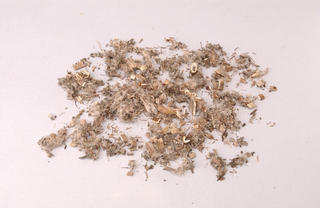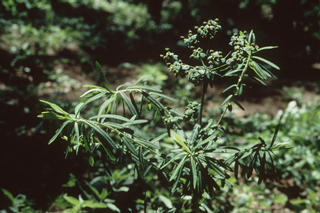Euphorbia pekinensis
Contents
Nomenclature
Other Names:
Historical Use of Euphorbia pekinensis
Euphorbia pekinensis in Traditional Chinese Medicine
Background
Hongya Daji ºìÑ¿´óêª
Chinese Name (pinyin): Daji
Chinese Name :
Common Name :Peking Spurge Root
Specific Name : Herba cirsii japonici/ Radix cirsii japonici
Scientific Name:
Collection :
Description :
Identification :
Processing :
Action : To arrest bleeding by reducing heat in the blood, to remove blood stasis, and to promote the subsidence of swelling.
Indication :
Precautions :
Dosage : 9 to 15 g; for external use, appropriate quantity of the fresh herb to be pounded into paste and applied topically.
Storage : Preserve in a ventilated and dry place.
Nomenclature
Other Names:
Historical Use of Euphorbia pekinensis
Euphorbia pekinensis in Traditional Chinese Medicine
Background
Chinese Name (pinyin): Jingdaji
Chinese Name :
Common Name :Peking Euphorbia Root
Specific Name : Radix euphorbiae pekinensis
Scientific Name:
Collection : The drug is collected in autumn and winter, wash clean and dried in the sun.
Description : Irregularly long conical, slightly curved, usually branched, 10 - 20 cm long, 1.5 - 4 cm in diameter. Externally greyish brown or brown, rough, exhibiting longitudinal wrinkles, transverse lenticels and branch root scars. Apex slightly expanded with numerous stem bases and bud scars. Texture hard, uneasily broken, fracture whitish or pale yellow and fibrous. Odour slight, taste slightly bitter and astringent.
Identification : 1.Powder: Pale yellow, simple starch granules subspheroid or ovoid. 3 - 15 µm in diameter, hilum pointed or slit shaped. Compound granules of 2 - 3 components. Cluster of calcium oxalate 19 - 40 µm in diameter. Bordered pitted and reticulate vessels more commonly found, 26 - 50 µm in diameter. Fibres individual or in bundles, walls relatively thick and non lignified. Non-articulate laticiferous tubes mostly broken containing yellow minute latex granules.2.To a slice of the drug add 1 drop of each of the glacial acetic acid and sulfuric acid, observe under a microscope, a red colour is produced at the laticiferous tubes of phloem which gradually disappears within 5 minutes, to another slice, add potassium hydroxide TS, a brownish yellow colour is produced.Processing: Eliminate foreign matter, wash clean, soften thoroughly, cut into thick slices and dry.
Processing : Eliminate foreign matter, wash clean, soften thoroughly, cut into thick slices and dry.Processed with vinegar: Boil as described under the method of boiling with vinegar (Appendix ll D) until vinegar is exhausted. Use 30 kg of vinegar per 100 kg of Radix Euphorbiae Pekinensis.
Action : To cause drastirc purgation.
Indication : anasarca, hydrothorax, ascites with dyspnea, constipation and oliguria
Precautions : Contraindicated in pregnancy. Incompatible with Radix Glycyrrhizae.
Dosage : 1.5 to 3 g.
Storage : Preserve in a dry place, protected from moth.
Synonymns for Euphorbia pekinensis
Patent Medicines and Medicines with Multiple Ingredients that include Euphorbia pekinensis
Pharmaceutical Information
Chemical Constituents
Evidence or the Use of Euphorbia pekinensis in the Treatment of Epilepesy
Basic Science
Animal Studies
Cohort, Case-Control and Non-Randomized Trials
Randomized Controlled Trials
Meta-Analysis
1st Five Results: pubmed search
Bingbing Liu, Jie Cao, Lu Liu, Min Zeng, Hongli Yu, Hao Wu
Metabolomics-based investigation of the chemical composition changes in Mongolian medicinal plant Euphorbia pekinensis before and after processing with Chebulae Fructus.
J Pharm Biomed Anal: 2024, 238;115838
[PubMed:37948776]
[WorldCat.org]
[DOI]
(I p)
Xiao-Qin Gao, Jin-di Xu, Shi-Kang Zhou, Yi Zhang, Li Zhang
[Jujubae Fructus alleviates intestinal injury caused by toxic medicinals in Shizao Decoction based on correlation between intestinal flora and host metabolism].
Zhongguo Zhong Yao Za Zhi: 2023, 48(10);2792-2802
[PubMed:37282939]
[WorldCat.org]
[DOI]
(P p)
Shi-Jin Shen, Zi-Yun Feng, Song-Jie Jiang, Li Liu, Shi-Jing Fu, Wan-Hong Chen, Qi-Yue Sun, Jian-Jun Chen
Azaphilones from the Fungus Penicillium multicolor LZUC-S2 and Their Antibacterial Activity.
Chem Biodivers: 2023, 20(3);e202201180
[PubMed:36785981]
[WorldCat.org]
[DOI]
(I p)
Xiao-Tao Zeng, Yan-Yan Chen, Shi-Jun Yue, Ding-Qiao Xu, Rui-Jia Fu, Jie-Yang, Yu-Ping Tang
A three-dimensional integration strategy for Q-markers identification: Taken Euphorbia Pekinensis Radix as an example.
J Pharm Biomed Anal: 2023, 224;115170
[PubMed:36435085]
[WorldCat.org]
[DOI]
(I p)
Kuilong Wang, Xiaofen Xu, Qiyuan Shan, Rui Ding, Qiang Lyu, Lichuang Huang, Xinyi Chen, Xin Han, Qiao Yang, Xianan Sang, Mengyun Peng, Min Hao, Gang Cao
Integrated gut microbiota and serum metabolomics reveal the protective effect of oleanolic acid on liver and kidney-injured rats induced by Euphorbia pekinensis.
Phytother Res: 2022;
[PubMed:36426741]
[WorldCat.org]
[DOI]
(I a)

